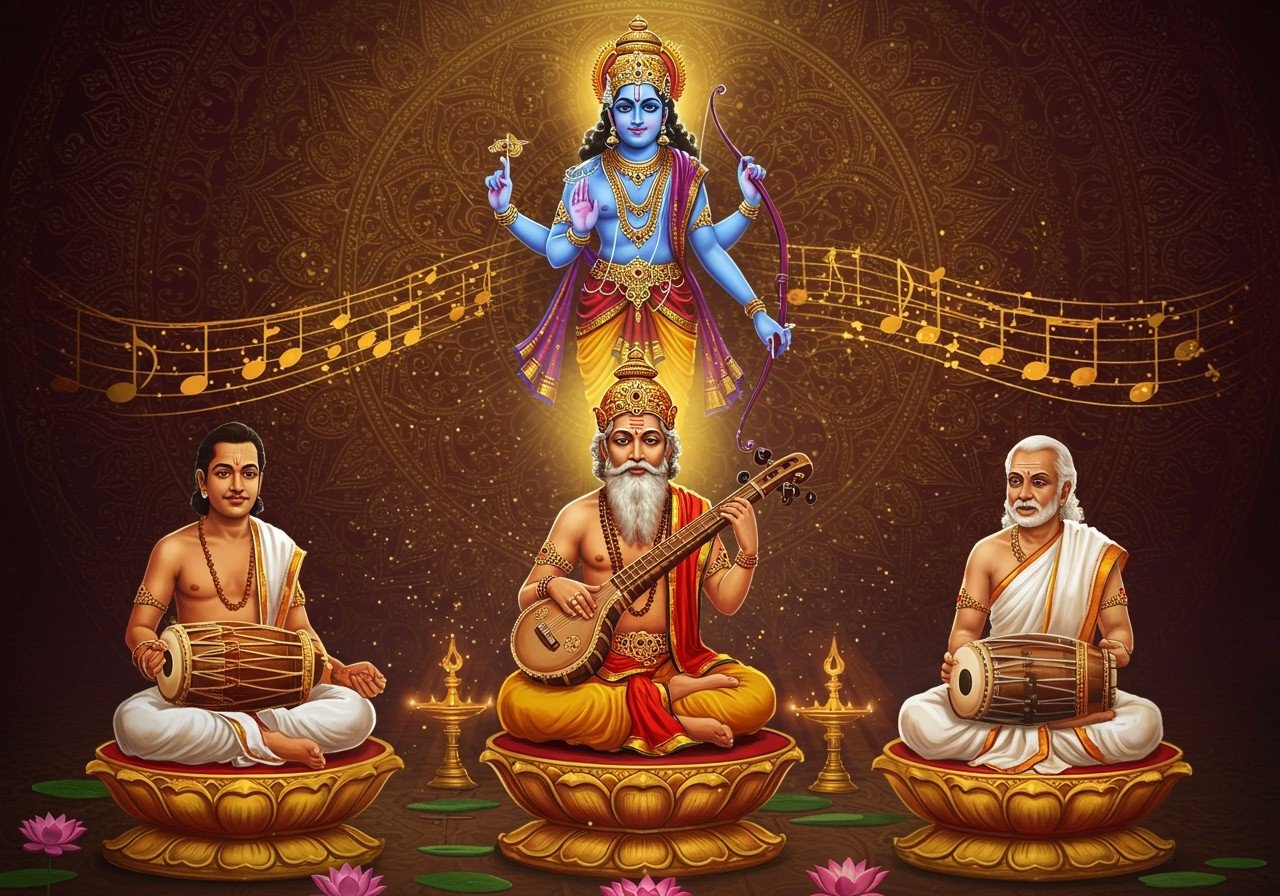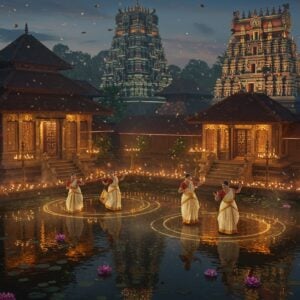
Carnatic music, a treasure of South India, reverberates with devotion and artistry. At its core shines the brilliance of the Carnatic Trinity – Tyagaraja, Muthuswami Dikshitar, and Syama Sastri. These maestros have shaped the very soul of this classical tradition. Join us as we journey through their lives, compositions, and the enduring legacy they’ve woven into the fabric of Indian music.
Delving into the Heart of Carnatic Music
Carnatic music, originating from South India, is a system steeped in devotion and intricate musicality. Its structure rests upon ragas (melodic frameworks) and talas (rhythmic cycles), creating a tapestry of sound that has evolved over centuries. Woven into the music are hymns dedicated to various deities, transforming each performance into a spiritual experience. Carnatic music isn’t merely entertainment; it’s a pathway to divine connection.
Tyagaraja: The Devotee Composer
Born in 1767 in Thiruvarur, Tyagaraja stands as a beacon of devotion and musical genius. Raised in a spiritually rich household, his musical journey began under the guidance of his father, a scholar of the Vedas and music. Tyagaraja’s deep devotion to Lord Rama infused his music with profound emotion. His compositions, known as kritis, are heartfelt expressions of his spiritual yearning.
With over 700 kritis attributed to him, Tyagaraja’s contribution is immense. The annual Tyagaraja Aradhana, a music festival held in his honor, is a testament to his enduring legacy. This vibrant celebration attracts musicians and devotees from all corners of the globe, keeping his spirit alive through music.
Muthuswami Dikshitar: The Wanderer Composer
Muthuswami Dikshitar, born in 1775, embarked on a unique musical path. His extensive travels exposed him to a diverse range of musical styles, including Western influences, which colored his compositions with distinctive hues. Dikshitar’s work is celebrated for its intricate rhythms and incorporation of rare ragas. His preference for Sanskrit lyrics imbued his music with philosophical depth, often centered around deities and profound themes. His masterful fusion of complex rhythms and melodic beauty continues to inspire musicians to this day.
Syama Sastri: The Rhythmic Master
Completing the Trinity is Syama Sastri, born in 1762. His unwavering devotion to Goddess Kamakshi is reflected in his compositions, each a glimpse into his spiritual world. Sastri’s mastery over talas distinguishes his work, showcasing his unique rhythmic ingenuity. His use of Telugu and Sanskrit in his kritis adds a rich linguistic layer to the Carnatic tradition.
Syama Sastri’s dedication to both tradition and innovation makes him a vital thread in the tapestry of Carnatic music. His emotionally resonant and technically brilliant compositions continue to be treasured by musicians and listeners alike.
The Enduring Impact of the Carnatic Trinity
The combined influence of these three musical giants is immeasurable. Their compositions form the bedrock of Carnatic music education, shaping generations of artists. Their innovative approach to ragas and talas has established benchmarks that continue to guide performance practices. The kriti format, which they championed, remains central to the tradition, encapsulating the creativity and depth of this classical art form.
A Living Legacy in the Modern World
The legacy of the Carnatic Trinity flourishes in contemporary times. Their music resonates with musicians and audiences worldwide, transcending geographical boundaries. Technology has played a key role in disseminating their work, ensuring their timeless appeal reaches new ears. In today’s fast-paced world, their devotional themes offer a sanctuary of solace and cultural connection. Ongoing research and scholarly work continually unveil fresh perspectives on their lives and music, deepening our understanding of their invaluable contribution.
Poojn.in: Your Companion on Your Carnatic Musical Journey
At Poojn.in, we understand the deep significance of Carnatic music traditions. We offer authentic Radha Krishna Bigraha, Shiva Lingam and other items that hold a special place in these traditions, particularly in connection with Saint Tyagaraja’s compositions. Whether you are looking for traditional items for your personal worship or seeking to honor these musical saints, we have curated a collection to support your spiritual practice.
Why choose Poojn.in?
- Authenticity: We source and verify all our products for authenticity, ensuring the sanctity of your musical and spiritual practices. We understand that using genuine items is crucial for maintaining the integrity of traditional practices.
- Quality: We offer items made from pure materials, meeting traditional standards. We believe that quality reflects respect for the rituals and traditions.
- Convenience: With convenient home delivery across India, you can easily access the items you need. We make it simple for you to obtain the items essential for your practices.
- Guidance: Our team is available to provide expert guidance on the proper usage of ritual items. We’re here to help you understand and perform your rituals correctly.
Contact us for personalized assistance:
- Phone: 03369029784
- WhatsApp: 9476142738
Visit poojn.in today to explore our complete collection of authentic puja items.
Celebrating the Timeless Melodies
As we delve into the lives and works of Tyagaraja, Muthuswami Dikshitar, and Syama Sastri, we recognize their music as a timeless gift. These luminaries of the Carnatic Trinity have left an indelible mark, intertwining spirituality and artistry into the heart of South Indian classical music. Their compositions, rich in devotion and innovation, are cornerstones of musical education and performance. By honoring their contributions, we not only preserve a precious part of our cultural heritage but also find inspiration and solace in their melodies. Embracing modern platforms to explore and share their work ensures that their voices continue to echo through generations, connecting the past with the present.
Let us celebrate their enduring influence and continue to cherish the rich traditions they have bequeathed to us. May the eternal melodies of the Carnatic Trinity continue to bring joy and peace to our lives.
Krishna’s Flute: Symbolism of Music, Divinity, and Devotion
Krishna’s Ten Avatars (Dashavatara) Explained: Krishna’s Significance
Varaha, Lakshmi & Narasimha Avatars: Exploring the Divine Trinity’s Significance
Sri Bhoo Varahaswamy Temple, Kallahalli, Mysore: A Visitor’s Guide


